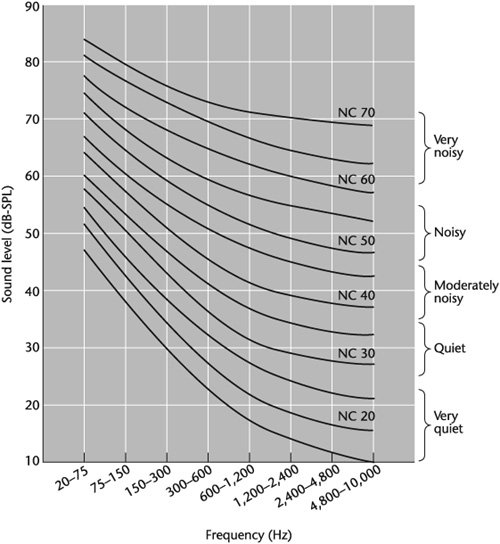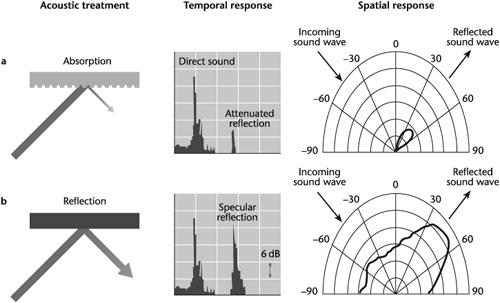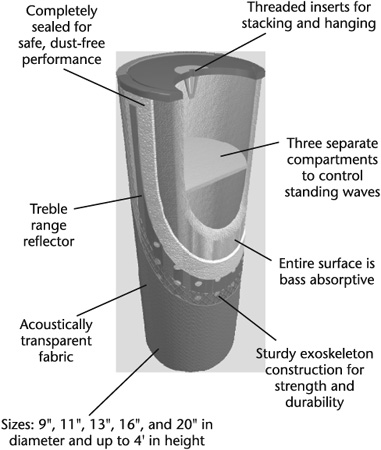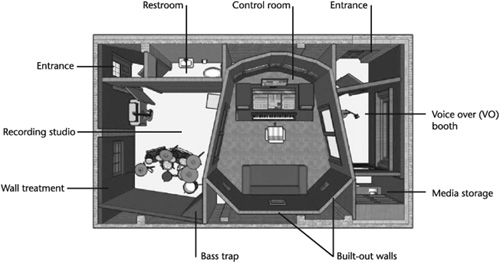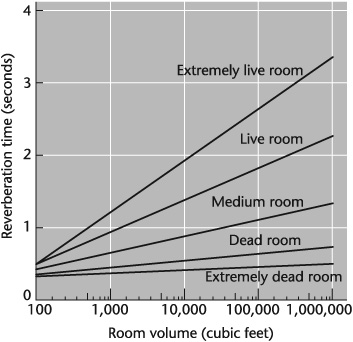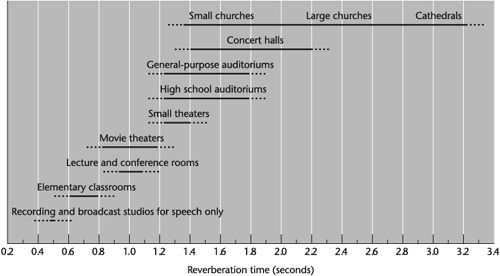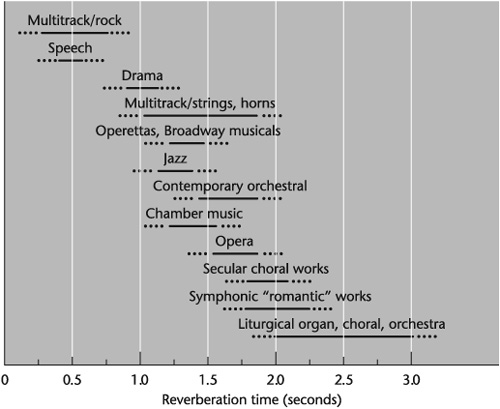When a sound wave is emitted in an enclosed space, it bounces off the surfaces of that space. Each surface affects the travels of the wave, depending on its sound-absorbing properties, size, and shape. Some frequencies are absorbed; others are reflected or diffracted. Some waves travel a short distance, bouncing off surfaces once or twice. Waves that travel longer distances arrive later, weaker, and tonally altered.
The science of a sound wave’s behavior—that is, its generation, transmission, reception, and effects—is called acoustics. The study that deals with the human perception of acoustics is called psychoacoustics. The term acoustics is used to describe the physical behavior of sound waves in a room; in this context, psychoacoustics is concerned with the relationship of our subjective response to such sound waves.
The acoustic and psychoacoustic considerations in designing performance studios and control rooms differ because of their primary purposes. Studios are designed for sound suitable for microphone pickup, whereas control rooms are designed for listening to loudspeakers. A home or small project studio may require accommodation for both functions. Appropriate studio acoustics vary with the type of audio produced. Voice-overs and narration, for example, require a relatively dry acoustic environment, whereas orchestral music requires a more reverberant setting. (See “Relationship of Studio Acoustics to Program Material” later in this chapter.) Recordings made in studios in which the acoustics are not quite suitable are provided with the appropriate acoustics artificially in the mixdown (see Chapters 11 and 13).
To accurately assess the reproduced sound in a control room, the main challenge is to reduce the number of unwanted reflections at the stereo and surround-sound monitoring locations so that they are relatively reflection-free zones.
In facilities designed by professional control room architects and acousticians, monitoring environments are less problematic than they are in the burgeoning number of project or home studios that may be housed in a living room, den, basement, or garage. In either case, however, unless the monitoring room is acoustically suitable for its sonic purpose, it seriously inhibits the ability to accurately evaluate the sound quality of audio material. (Control room monitoring is discussed in Chapter 5, “Monitoring.”)
The behavior of sound waves in an acoustic environment and how that behavior affects aural perception leads logically to a consideration of the four factors that influence this behavior: sound isolation, room dimensions, room shape, and room acoustics. These factors are directly related to one overriding concern: noise.
Noise—unwanted sound—is the number one enemy in audio production. As noted in Chapter 2, noise is everywhere. Outside a room, it comes from traffic, airplanes, jackhammers, thunder, rain, and so on. Inside a room, it is generated by fluorescent lights, heating, ventilation and air conditioning (HVAC) systems, computers, and appliances. And these are only the more obvious examples. A few not-so-obvious examples include the “noise” made by the random motion of molecules, by our nervous and circulatory systems, and by our ears. In short, noise is part of our existence and can never be completely eliminated. (Audio equipment also generates system noise.) Even though unwanted sound is always present, when producing audio it must be brought to within tolerable levels so that it does not interfere with the desired sound, particularly with digital recording. Among other things, noise can mask sounds, make speech unintelligible, create distraction, cause annoyance, and reduce if not ruin the aesthetic listening experience.
To this end, acousticians have developed noise criteria (NC) that identify, by means of a rating system, background noise levels (see Figure 4-1). From this rating system, NC levels for various types of rooms are derived (see Figure 4-2). This raises the question: Once NC levels for a particular room are known, how is noise control accomplished?
Sound studios must be isolated to prevent outside noise from leaking into the room and to keep loud sound levels generated inside the room from disturbing neighbors. This is accomplished in two ways. The first is by determining the loudest outside sound level against the minimum acceptable NC level inside the studio. This is usually between NC 15 and NC 25 (approximately 25 to 35 dBA[1]), depending on the type of sound for which the studio is used. It is also done by determining the loudest sound level inside the studio against a maximum acceptable noise floor outside the studio.
For example, assume that the maximum measured noise outside a studio is 90 dB-SPL and the maximum acceptable noise level inside the studio is 30 dB-SPL at, say, 500 Hz. (These values are always frequency-dependent but are usually based on 500 Hz.) This means the construction of the studio must reduce the loudness of the outside sound level by 60 dB. If the loudest sound inside a studio is 110 dB-SPL and the maximum acceptable noise outside the studio is 45 dB-SPL, the studio’s construction must reduce the loudness level by 65 dB.
The amount of sound reduction provided by a partition, such as a wall, floor, or ceiling, is referred to as transmission loss (TL). Because TL works both ways, determining partition requirements is equally applicable to sound traveling from inside to outside the studio. Therefore, the partitions constructed to isolate the studio in this example would have to reduce the loudness level by at least 65 dB (500 Hz).
Just as it is convenient to define a noise spectrum by a single NC rating, it is useful to measure a partition on the basis of its transmission loss; such a measurement is called sound transmission class (STC). Sound transmission class varies with the type and the mass of materials in a partition. If a 4-inch concrete block has an STC of 48, it indicates that sound passing through it will be attenuated by 48 dB. An 8-inch concrete block with an STC of 52 attenuates 4 dB more sound than the 4-inch block. Plastering both sides of the concrete block would add 8 dB more sound attenuation.
Sometimes a studio’s dimensions accentuate noise by reinforcing certain frequencies, thereby altering, or “coloring,” the natural sound. This may also affect the response of a sound’s decay (see Figure 4-3). Such coloration affects perception of tonal balance, clarity, and imaging as well. Audio mixed in a control room with these problems will sound markedly different when played in another room. Other factors related to the shape of a studio and the construction materials used therein (discussed in the following two sections) may also affect coloration.
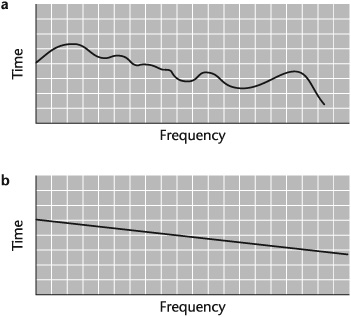
Figure 4-3. Reverberation decay responses. (a) Irregular reverb decay, which is undesirable because it creates unwanted sound coloration. (b) Desirable reverb decay, illustrating no resonant coloration. This acoustic condition is always strived for but in practice is rarely attained.
Rooms have particular resonances at which sound will be naturally sustained. These are related to the room’s dimensions. Resonance results when a vibrating body with the same natural frequencies as another body causes it to vibrate sympathetically and increases the amplitude of both at those frequencies if the vibrations are in acoustical phase.
Resonances occur in a room at frequencies whose wavelengths are the same as or a multiple of one of the room’s dimensions. These resonances, called eigentones, or more commonly, room modes, are increases in loudness at resonant frequencies that are a function of a room’s dimensions. When these dimensions are the same as or multiples of a common value, the resonance amplitude is increased. Such a room’s dimensions may be 10 × 20 × 30 feet, or 15 × 30 × 45 feet. This creates unequal representation of the frequencies generated by a sound source. In other words, certain frequencies will be reinforced while others will not. To avoid additive resonances, room dimensions should not be the same nor be integer multiples of one another. Dimensions of, say, 9 × 10.1 × 12.5 feet or 15 × 27 × 31.5 feet would be satisfactory. It should be noted, however, that although perfect dimensions are the ideal, they are rarely a reality. Most studios will have some resonant frequencies. Figure 4-4 shows a graph of acceptable room ratios.
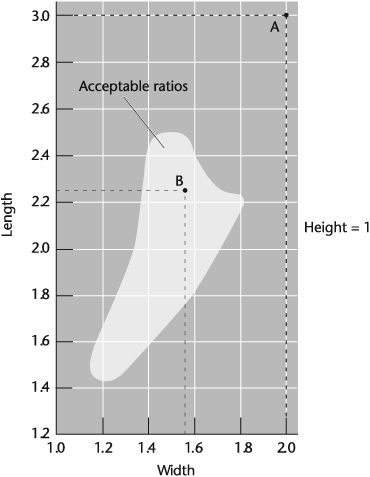
From Broadcast Engineering magazine, February 2003, p.78 © 2003 Mondo Code.
Figure 4-4. Acceptable ratios to control room resonances. Using this pictogram, developed by Newman, Blot, and Baranek in 1957, involves three basic steps: (1) divide all room dimensions by the height (making height equal to 1); (2) plot width and length on the horizontal and vertical scales; and (3) determine acceptability by noting whether the plot is in or out of the “zone.”
Resonance is not always bad, however. The tubing in wind and brass instruments; the pipes in an organ; and the human mouth, nose, chest, and throat are resonators. Air columns passing through them excite resonant frequencies, creating sound. Without resonators such as the “box” of a guitar or violin, weak sound sources would generate little sound. Some studios use this principle to construct resonators that help amplify certain frequencies to enhance the type of sound produced. The section titled “Room Acoustics” later in this chapter explains how resonators are also used to absorb sound.
Acoustics is a science of interacting relationships. Although a studio’s walls, floors, and windows may have been properly constructed and their dimensions conform to a set of preferred standards, the room’s shape also influences noise reduction and sound dispersion.
Except for bass frequencies, sound behaves like light; its angle of incidence is equal to its angle of reflectance (see Figure 4-5). If a studio has reflective parallel walls, sound waves reinforce themselves as they continuously bounce between opposing surfaces (see Figure 4-6). These are called standing waves. Another phenomenon associated with parallel walls is flutter echo where multiple, short reflections produce a ringing decay of varying duration. If there are concave surfaces, they serve as collecting points, generating unwanted concentrations of sound (see Figure 4-7a). A studio, whether professional or home based, should be designed to break up the paths of sound waves (see Figure 4-7b and Figure 4-7c).

Figure 4-5. Angle of incidence and angle of reflectance. In sound, as in light, these angles are equal.
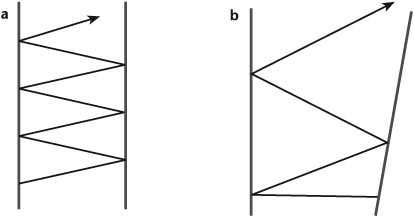
Figure 4-6. Parallel walls. (a) Sound waves reflect back along their original paths of travel, thereby generating standing waves that are reinforced, creating echoey sound. (b) Slightly changing the angle of one wall reduces the possibility of the reflections’ following repeated paths.
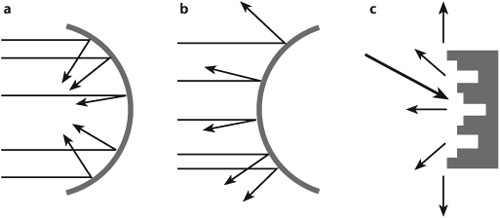
Figure 4-7. Shape of a room’s surface affecting direction of sound reflections. (a) Concave surfaces concentrate sound waves by converging them. (b) Convex surfaces are more suitable in studios because they disperse sound waves. (c) A quadratic residue diffuser also disperses waves at many different angles.
Typical studio designs have adjacent walls at angles other than 90 degrees and different-shaped wall surfaces, such as spherical, cylindrical, serrated, and pyramidal, to help disperse the sound waves (see Figure 4-8). Even the glass between the studio and the control room is angled toward the floor for sound dispersal (and to avoid light reflections), but this is not enough to break up the paths of sound waves; they must be controlled once they hit a surface.
When sound hits a surface, one reaction—or a combination of five reactions—happens, depending on the surface’s material, mass, and design. Sound is absorbed, reflected, partially absorbed and reflected, diffracted, or diffused.
When sound hits a surface and is absorbed, it is soaked up: There is little or no reflection, and the sonic result is lifeless, or dry. When sound hits a surface and is reflected, it bounces off the surface and is perceived as reverberation or echo, depending on its interaction with other live surfaces in the vicinity. Conditions under which sound is completely absorbed or reflected are rare. Most materials absorb and reflect sound to some degree (see Figure 4-9).
The amount of indirect sound energy absorbed is given an acoustical rating called a sound absorption coefficient (SAC), also known as a noise reduction coefficient (NRC). Theoretically, on a scale from 1.0 to 0.0, material with a sound absorption coefficient of 1.0 completely absorbs sound, whereas material with an NRC of 0.0 is completely sound reflectant. Soft, porous materials absorb more sound than hard, nonporous materials. Drapes, for example, have a higher absorption coefficient than glass. Sound absorption ratings for the same material vary with frequency, however. For example: The sound absorption coefficient of a light, porous concrete block at 125 Hz is 0.36, at 500 Hz it is 0.31, and at 4,000 Hz it is 0.25; heavy plate glass has a SAC of 0.18 at 125 Hz, 0.04 at 500 Hz, and 0.02 at 4,000 Hz; wood parquet’s SAC is 0.04 at 125 Hz, 0.07 at 500 Hz, and 0.07 at 4,000 Hz. A list of sound absorption coefficients for many types of materials can be found at acoustic provider websites such as www.acousticalsurfaces.com.
Three types of acoustic absorbers are porous absorbers, diaphragmatic absorbers, and Helmholtz absorbers. Porous absorbers come in an ever increasing variety of materials, shapes and sizes, including polyurethane and melamine foams (see Figure 4-10), sintered glass, transparent fiber free panels and films, absorptive building materials such as wood and plaster, and metal bass management plate absorbers. Porous absorbers are most effective with high frequencies. Because the wavelengths of high frequencies are short, they tend to get trapped in the tiny air spaces of the porous materials. The thicker and denser the absorbent, the greater the sound absorption—but only to a point. If the material is overly dense, it will act more like a hard wall and reject high-frequency sound. In the middle and lower frequencies, however, an overly dense absorber improves absorption.
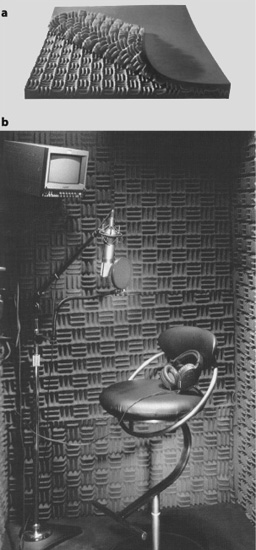
Figure 4-10. Polyurethane-foam sound absorber. (a) In sheet form, ready to install. (b) Applied to a voice-over room to control unwanted acoustic reflections.
Diaphragmatic absorbers are generally flexible panels of wood or pressed wood mounted over an air space. When a sound wave hits the panel, it resonates at a frequency (or frequencies) determined by the stiffness of the panel and the size of the air space. Other sound waves of the same frequency (or frequencies) approaching the panel, therefore, are dampened. Diaphragmatic absorbers are used mainly to absorb low frequencies; for this reason, they are also called bass traps (see Figure 4-11). This principle can also be applied to absorbing high frequencies.
Because it is difficult to completely dissipate standing waves, especially in small rooms and even with optimal acoustics, bass traps are usually designed to introduce significant absorption for frequencies between 30 Hz and 100 Hz.
A Helmholtz absorber, also called a Helmholtz resonator, is a tuned absorber designed to remove sound at specific frequencies or within specific frequency ranges, usually the lower-middle frequencies. It functions, in principle, not unlike the action created when blowing into the mouth of a soda bottle. The tone created at the frequency of the bottle’s resonance is related to the air mass in the bottle. By filling the bottle with water, the air mass is reduced, so the pitch of the tone is higher.
When sound reaches a surface, in addition to being partially absorbed and reflected, it diffracts—spreads around the surface. The amount of diffraction depends on the relationship between wavelength and the distances involved. You will recall that each frequency has a wavelength; bass waves are longer, and treble waves are shorter. Hence, the diffraction of bass waves is more difficult to control acoustically than the diffraction of treble waves.
The overriding challenge for the acoustician is controlling the physical behavior of sound waves in a studio. The goal is the uniform distribution of sound energy in a room so that its intensity throughout the room is approximately uniform (see Figure 4-12). This is called diffusion.
No matter how weak or strong the sound and regardless of its wavelength, the diffused energy is reduced in amplitude and spread out in time, falling off more or less exponentially. Figure 4-13 displays an example of a combined acoustic treatment.
Basic principles of acoustics apply to any room in which sound is generated. As noted earlier, however, a room’s purpose greatly influences how those principles are applied. If a studio is used for rock music and speech, the acoustics must absorb more sound than they diffuse so that there is minimal interference from other sounds and/or from reverberation. On the other hand, studios used for classical music and some types of jazz should diffuse more sound than they absorb to maintain balanced, blended, open sound imaging.
Theoretically, this means that a studio designed to fulfill one sonic purpose is inappropriate for another. In fact, to be more functional, some studios are designed with variable acoustics. They have adjustable panels, louvers, or partitions and portable baffles, or gobos, to alter diffusion, absorption, and reverb time (see Figures 4-14, 4-15, and 4-16).
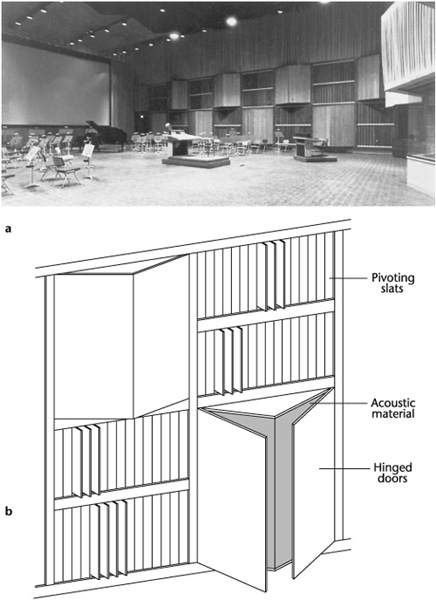
Figure 4-14. Acoustic treatment along walls. (a) Scoring stage with alternating doors and slats that can be opened or closed to vary acoustics. (b) Detail of doors and slats shown in (a).
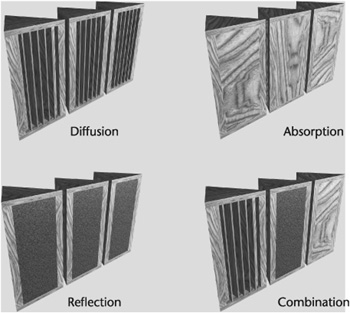
Figure 4-15. Trifussor. Variable equilateral triangle prism acoustic modules can be rotated to expose absorptive, reflective, and diffusive sides in any combination, thereby refining reverb times. For example, in recording an orchestra, the modules adjacent to strings and woodwinds could be turned to their reflective side to enhance these weaker-sounding instruments, and panels nearer brass and tympani could be turned to their absorptive side to help control these strong-sounding instruments.
Home and small project recording and postproduction studios are increasingly popular among professionals, audiophiles, and amateur enthusiasts. Although the terms are used interchangeably, the differences between home and project studios usually come down to whether the facility is commercial or not. Project studios typically are; home studios may or may not be. In either case, construction and acoustic considerations are similar. Adapting living space, a basement, or a garage to suit particular needs is often an attractive and affordable alternative to renting studio time. While the general principles and issues of sound isolation, room characteristics, and acoustics are the same as for a professionally designed and built studio, there are a number of considerations particular to working at home or in a small space adapted for audio recording.
In a home or small project studio, sound transmission is a key issue—neighbors don’t necessarily want to hear you recording in the middle of the night, and you don’t want the sounds of the street on the recording or to be a distraction when editing and mixing. Ideally, situating the studio below ground or in a basement has the advantage of reducing noise transmission. Inner and outer walls may be reinforced acoustically by adding another layer of drywall or acoustically absorbent paneling. If this is built out from an existing wall with additional framing, the space in between forms an important bass trap (see Figure 4-11), thereby further reducing unwanted lower frequencies. Carpeting a room and using acoustic carpet underlay—often made of rubber and felt—can reduce the transmission of unwanted sound through the floor.
One of the most challenging aspects of designing a home-based studio involves room dimension and shape with attendant acoustic problems. Where possible, try not to situate the studio in a small, square room. If there is no option, make sure that walls, floor, and ceiling treatments have sufficient absorption to neutralize flutter echoes. Generally, a larger space with a high ceiling offers greater possibilities and better sound for both recording and monitoring.
In a home studio, it is often difficult to avoid perpendicular and parallel walls, whether in a basement, study, or a bedroom. One solution is to position the monitoring location in a corner where there is less risk of standing waves and flutter echo as sound reflects back and forth across a room. But be aware that such positioning may unduly increase bass response (see Figure 5-9). Moveable office partitions with appropriate fabric or other noise-reducing material are also useful in configuring a space for both recording and listening. They have the advantage of coming in various sizes and can be easily stored in a small space.
Consider the acoustic characteristics of the recording and monitoring space(s) and take appropriate measures to control and address problematic issues. Porous absorbers are perhaps the most popular type of acoustic treatment for the home or small project studio. These can often complement surface treatments that are part of a room’s decor, where carpeting, curtains, acoustic tile ceilings all contribute to the sonic character of the space. Remember that the walls in most home and small project spaces are drywall (gypsum plaster board), brick, or cinderblock—all highly reflective surfaces. Some treatment will be required to control the interplay of absorption and reflection of sound effectively.
As with any construction project, planning and anticipating the varied uses of a space is essential. So, before knocking out walls, think through the studio design and layout with regard to the kind of audio recording and production projects undertaken. In such planning, be sure to factor in providing easy access to the studio for musicians and additional production personnel and making sure there is sufficient performance and working space (see Figure 4-17).
Although the science of acoustics is highly developed, there is no such thing as a sound room with perfect acoustics. The sonic requirements of rock-and-roll and classical music, for example, are different, as they are for a radio studio and a studio used for dialogue rerecording in film and television.
A reverberant studio might be suitable for a symphony orchestra because the reflections add needed richness to the music, as they do in a concert hall. The extremely loud music a rock group generates would swim amid too many sound reflections, becoming virtually unintelligible. At the same time, a studio with relatively few reflections, and therefore suitable for rock-and-roll, would render the sound of a symphony orchestra small and lifeless.
A radio studio is relatively quiet but does have some room tone, or atmosphere, so the sound is not too closed down or closet-like. In radio, it is important to maintain the intimate sonic rapport between announcer and listener essential to the personal nature of the medium. Rerecording dialogue in postproduction for a film or TV drama requires a studio virtually devoid of room tone to prevent acoustics from coloring the dialogue so that room tone appropriate to a scene’s setting can be added later.
Rooms with reverberation times of one second or more are considered “live.” Rooms with reverberation times of one-half second or less are considered “dry,” or “dead” (see Figure 4-18). Live rooms reinforce sound, making it relatively louder and more powerful, especially, although not always, in the lower frequencies. They also tend to diffuse detail, smoothing inconsistencies in pitch, tonal quality, and performance.
In dry rooms, sound is reinforced little or not at all, causing it to be concentrated and lifeless. Inconsistencies in pitch, tonal quality, and other aspects of undesirable performance are readily apparent. In instances where dry rooms are required for recording, signal processing is used to provide appropriate reverberation (see Figure 4-19 and Chapter 11). Liveness can be added by increasing the frequencies between roughly 500 and 2,000 Hz and adding reverberation in the range of one to two seconds. Other aspects to consider in the acoustics of a room or recording—depending on the type of program material—are warmth, intimacy, clarity, and auditory source width.
Warmth is a sonic quality usually associated with the lower frequencies and increased reverberation time—specifically, the frequencies between roughly 125 and 250 Hz—and a high reverb time relative to the midrange frequencies.
Intimacy relates to being a part of the performance and connected with the performers. It results from early reflections that follow the direct sound by no more than 15 to 20 ms.
Clarity refers to the ability to hear sonic detail, such as understanding lyrics or the attack of orchestral sections or a solo instrument. Clarity increases as the direct-to-reverberant sound ratio decreases. Clarity is extremely high in a dry studio, but the sound would not be enjoyable, so clarity must be judged in relation to the amount of reverb in a sound.
Auditory source width (ASW) refers to how wide a sound source is perceived to be compared with how wide it actually is. This is a result of both the reverberation values in a room or recording and, in a recording, the microphone and panning techniques by which a spatial illusion is created.
Acousticians have calculated optimum reverb times for various types of audio material that have proved suitable for emulation in the production room (see Figure 4-20). That said, preference for the amount of reverberation and reverb time is a matter of individual taste and perception—and perceptions differ, even among the experts. This is one reason why, for example, concert venues of relatively the same dimensions, or acoustic properties, or both, sound different. One hall may be drier and spare sounding, another more reverberant and rich sounding. Then there are concert venues of such dimensions that they require electronic reinforcement through small loudspeakers throughout the hall to ensure optimal distribution of the direct sound and the early and late reflections.
Generally, it is agreed that certain reverb times for speech, pop and rock music, and orchestral music are desirable. For example, for the intimate clarity of speech in radio, a drier reverb time value of 0.4 to 0.6 seconds is considered suitable while 0.5 to 0.7 seconds is acceptable for lecture speech. Too long a reverb time creates a distant, more echoey sound. Too short a reverb time gives speech too dry a quality and is usually uncomfortable for the speaker. Pop and rock require a short reverb time because the music is usually high energy; typically 0.5 to 0.6 seconds is recommended. Longer reverb times would create too many unwanted sound reflections and wash out too much detail. Orchestral music requires longer reverb times to add fullness and body to the sound; depending on the size of the orchestra, 1.5 to 2 seconds is preferred. Shorter reverb times could adversely affect blending and reduce the music’s liveness and vitality.
Sound control is obviously the most important factor in studio and control room design, but human needs should not be ignored. Production is stressful enough without personnel having to endure poor lighting, hard-to-reach equipment, uncomfortable chairs, and so on. Designing an engineering system with the human element in mind is called ergonomics.
Among the more important ergonomic considerations are comfortable lighting; sufficient room for personnel and furniture; functional, comfortable furniture; easily accessible equipment; static-free floor covering that facilitates anything on wheels to move about easily; and a computer workstation that reduces back strain and repetitive strain or stress discomfort in the fingers, hands, arms, and shoulders.
Production is demanding enough: Make it as efficient and easy as possible on the production personnel and yourself.
When a sound wave is emitted in an enclosed space, it bounces off the surfaces of that space. Each surface affects the travels of the wave, depending on its sound-absorbing properties, size, and shape.
Acoustics is the science of sound, including its generation, transmission, reception, and effects. Psychoacoustics deals with the human perception of sound. The term acoustics is also used to describe the physical behavior of sound waves in a room. In that context, psychoacoustics is concerned with the relationship of our subjective response to such sound waves.
The acoustic and psychoacoustic considerations in designing performance studios and control rooms differ because of their primary purposes. Studios are designed for sound suitable for microphone pickup, whereas control rooms are designed for listening to loudspeakers.
Four factors influence how sound behaves in an acoustic environment: sound isolation, room dimensions, room shape, and room acoustics.
Noise is any unwanted sound in the audio system, the studio, or the environment.
Sound isolation in a room is measured in two ways: by determining the loudest outside sound level against the minimum acceptable noise criteria (NC) level inside the room, and by determining the loudest sound level inside the studio against a maximum acceptable noise floor outside the room.
The NC system rates the level of background noise.
Transmission loss (TL) is the amount of sound reduction provided by a partition, such as a wall, floor, or ceiling. This value is given a measurement called sound transmission class (STC).
The dimensions of a sound room—height, width, and length—should not equal nor be exact multiples of one another. Room dimensions create additive resonances, reinforcing certain frequencies and not others and thereby coloring the sound.
Resonance, another important factor in studio design, results when a vibrating body with the same natural frequencies as another body causes that body to vibrate sympathetically, thereby increasing the amplitude of both at those frequencies if the variables are in acoustical phase.
The shape of a studio is significant for good noise reduction and sound dispersion.
When sound hits a surface, one or a combination of five reactions occurs: It is absorbed, reflected, partially absorbed and reflected, diffracted, or diffused.
The amount of indirect sound energy absorbed is given an acoustical rating called a sound absorption coefficient (SAC), also known as a noise reduction coefficient (NRC).
Three classifications of acoustic absorbers are porous absorbers, diaphragmatic absorbers, and Helmholtz absorbers or resonators.
When sound reaches a surface, in addition to being partially absorbed and reflected, it diffracts—or spreads around the surface.
Diffusion is the uniform distribution of sound energy in a room so that its intensity throughout the room is approximately uniform.
To be more acoustically functional, many studios are designed with adjustable acoustics—movable panels, louvers, walls, and gobos (portable baffles) to alter diffusion, absorption, and reverb time.
In designing a home and project studio, the overriding considerations are keeping studio sound from getting outside the room; preventing outside sound from getting into the room; room dimension and shape; acoustic control; equipment positioning; and access.
Although the science of acoustics is highly developed, there is no such thing as a sound room with perfect acoustics. In designing a studio, the relationship of its acoustics to the program material performed therein is a primary consideration.
Among the factors in designing an appropriate acoustic recording space are warmth, intimacy, clarity, and auditory source width.
Ergonomics addresses the design of an engineering system with human comfort and convenience in mind.
[1] The “A” in the dB value refers to the filter used for measuring frequency response that closely resembles the response of the human ear.

